|
|
|
Sort Order |
|
|
|
Items / Page
|
|
|
|
|
|
|
| Srl | Item |
| 1 |
ID:
112776
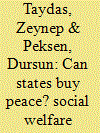

|
|
|
|
|
| Publication |
2012.
|
| Summary/Abstract |
This study examines whether the state's ability to provide social welfare services has any major effect on the probability of civil conflict onset. We argue that welfare spending contributes to sustaining peace because the provision of social services reduces grievances by offsetting the effects of poverty and inequality in society. Welfare spending serves as an indication of the commitment of the government to social services and reflects its priorities and dedication to citizens. By enacting welfare policies that improve the living standards of citizens, governments can co-opt the political opposition and decrease the incentives for organizing a rebellion. Utilizing time-series, cross-national data for the 1975-2005 period, the results indicate that as the level of the government investment in welfare policies (i.e. education, health, and social security) increases, the likelihood of civil conflict onset declines significantly, controlling for several other covariates of internal conflict. Additional data analysis shows that general public spending and military expenditures are unlikely to increase or decrease the probability of civil unrest. Overall, these findings suggest that certain types of public spending, such as welfare spending, might have a strong pacifying effect on civil conflict, and therefore the state's welfare efforts are vital for the maintenance of peace.
|
|
|
|
|
|
|
|
|
|
|
|
|
|
|
|
| 2 |
ID:
112777
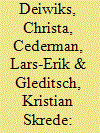

|
|
|
|
|
| Publication |
2012.
|
| Summary/Abstract |
Case study evidence suggests that inequality between regions in federations affects the risk of secessionist conflict. However, the conventional quantitative literature on civil war has found little support for a link between economic inequality and civil war. We argue that this seeming discrepancy in part stems from differences in the conceptualization of inequality and its operationalization, which has focused on individual-level wealth differences. In contrast, we investigate regional-level inequality, which is more readily applicable to understanding possible incentives for internal conflict. We adopt a spatial approach, based on new geo-coded data on administrative units in 31 federal states between 1991 and 2005, economic wealth, and ethnic settlements, and demonstrate strong evidence that regional inequality affects the risk of secessionist conflict. The results indicate that in highly unequal federations, both relatively developed and underdeveloped regions are indeed more likely to be involved in secessionist conflict than regions close to the country average. In addition, we provide evidence that exclusion from central state power as well as ethnic groups' access to regional institutions are associated with an increased risk for secessionist conflict. The findings on inequality remain robust even when controlling for other confounding factors such as country GDP, population and war history.
|
|
|
|
|
|
|
|
|
|
|
|
|
|
|
|
| 3 |
ID:
112781
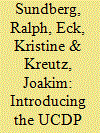

|
|
|
|
|
| Publication |
2012.
|
| Summary/Abstract |
This article extends the Uppsala Conflict Data Program (UCDP) by presenting new global data on non-state conflict, or armed conflict between two groups, neither of which is the state. The dataset includes conflicts between rebel groups and other organized militias, and thus serves as a complement to existing datasets on armed conflict which have either ignored this kind of violence or aggregated it into civil war. The dataset also includes cases of fighting between supporters of different political parties as well as cases of communal conflict, that is, conflict between two social groups, usually identified along ethnic or religious lines. This thus extends UCDP's conflict data collection to facilitate the study of topics like rebel fractionalization, paramilitary involvement in conflict violence, and communal or ethnic conflict. In the article, we present a background to the data collection and provide descriptive statistics for the period 1989-2008 and then illustrate how the data can be used with the case of Somalia. These data move beyond state-centric conceptions of collective violence to facilitate research into the causes and consequences of group violence which occurs without state participation.
|
|
|
|
|
|
|
|
|
|
|
|
|
|
|
|
| 4 |
ID:
112782
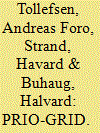

|
|
|
|
|
| Publication |
2012.
|
| Summary/Abstract |
Contributions to the quantitative civil war literature increasingly rely on geo-referenced data and disaggregated research designs. While this is a welcome trend, it necessitates geographic information systems (GIS) skills and imposes new challenges for data collection and analysis. So far, solutions to these challenges differ between studies, obstructing direct comparison of findings and hampering replication and extension of earlier work. This article presents a standardized structure for storing, manipulating, and analyzing high-resolution spatial data. PRIO-GRID is a vector grid network with a resolution of 0.5 x 0.5 decimal degrees, covering all terrestrial areas of the world. Gridded data comprise inherently apolitical entities; the grid cells are fixed in time and space, they are insensitive to political boundaries and developments, and they are completely exogenous to likely features of interest, such as civil war outbreak, ethnic settlement patterns, extreme weather events, or the spatial distribution of wealth. Moreover, unlike other disaggregated approaches, gridded data may be scaled up or down in a consistent manner by varying the resolution of the grid. The released dataset comes with cell-specific information on a large selection of political, economic, demographic, environmental, and conflict variables for all years, 1946-2008. A simple descriptive data assessment of population density and economic activity is offered to demonstrate how PRIO-GRID may be applied in quantitative social science research.
|
|
|
|
|
|
|
|
|
|
|
|
|
|
|
|
| 5 |
ID:
112778
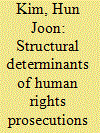

|
|
|
|
|
| Publication |
2012.
|
| Summary/Abstract |
Over the last three decades, a growing number of countries have experienced a transition from authoritarianism to democracy, and the new governments have been increasingly expected to address past human rights violations. While the academic literature on the impact of human rights prosecution is relatively well developed, the literature on the causes of such prosecution is still sparse. Why do states pursue criminal prosecutions against former state officials on the charge of human rights violations? This article answers this question by testing three key theories: the balance of power between old and new elites, transnational advocacy networks, and the diffusion theory. I conduct a cross-national study of 71 countries that were in a state of democratic transitions between 1980 and 2006, using a new dataset on domestic human rights prosecutions. I find strong evidence to support the transnational advocacy networks and diffusion explanations. First, active domestic and international human rights advocacy for individual criminal accountability is a key factor guaranteeing persistent and frequent human rights prosecutions. My study further shows that domestic advocacy plays a crucial role in criminal prosecutions of high-profile state officials while international pressure is more effective in promoting prosecutions of low-profile officials. Second, the diffusion theory is also supported since the occurrence of human rights prosecution in neighboring countries is a relevant factor. Interestingly, transitional countries are most sensitive to trials occurring in culturally or linguistically similar countries and this supports the constructivist norm diffusion theory, which focuses on the role of identity and communication in the diffusion process. However, I find that the power balance explanation, which has been the prevailing explanation, is valid only for the immediate use of human rights prosecutions.
|
|
|
|
|
|
|
|
|
|
|
|
|
|
|
|
| 6 |
ID:
112780
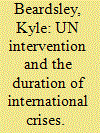

|
|
|
|
|
| Publication |
2012.
|
| Summary/Abstract |
This article examines the effect of UN actions on the duration of international crises. Four different types of action - assurance, diplomatic engagement, military involvement, and intimidation - and three different outcomes - compromise, victory, and stalemate - are considered. After building on the existing literature to develop expectations of how a third party like the UN shapes crisis trajectories, hypotheses are tested using the International Crisis Behavior (ICB) data and a new events dataset on UN activity. Results from competing-risks models reveal that UN military involvement does well to decrease the risk of one side achieving victory, and diplomatic engagement increases the ability of the belligerents to reach a compromise in the long run. Moreover, diplomatic engagement accompanied by military involvement substantially hastens the pace of stalemate outcomes. Both tactics, however, have some trade-offs. Military involvement can decrease the sense of urgency for compromise; diplomatic engagement can be used for insincere motives and increase the risk of one-sided victory over time. UN actions of assurance and simple intimidation have considerable shortcomings as crisis management vehicles.
|
|
|
|
|
|
|
|
|
|
|
|
|
|
|
|
| 7 |
ID:
112779
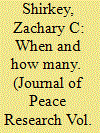

|
|
|
|
|
| Publication |
2012.
|
| Summary/Abstract |
What makes some wars longer and more severe than others is an important question in international relations scholarship. One underexplored answer to this question is the role that third party joiners play in lengthening conflicts, especially those states that intervene militarily after a war's initial stages. This article argues that late joining complicates bargaining by adding new issues to the war and increases uncertainty about the relative balance of forces. Thus, more information will be needed to resolve the bargaining impasse. This means additional fighting and a longer war. This lengthening in turn increases the number of casualties. This is a distinct process from simply having more participants in a war from the outset as those participants would not add uncertainty in the same way that late joiners do since questions about how those participants affect the relative balances of forces would be answered just as quickly as if there were only two participants at the outset. These claims are supported by a non-proportional hazards model regression, a Cox proportional hazards regression, and an ordinary least squares regression using the Correlates of War interstate war dataset.
|
|
|
|
|
|
|
|
|
|
|
|
|
|
|
|
|
|
|
|
|